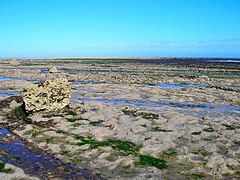| Gault Formation | |
|---|---|
| Stratigraphic range: Albian | |
 An exposed surface of Gault clay on the foreshore near Beachy Head, East Sussex | |
| Type | Geological formation |
| Unit of | Selborne Group |
| Underlies | Upper Greensand Formation, Cambridge Greensand, Chalk Group |
| Overlies | Monk's Bay Sandstone Formation, Folkestone Formation, Woburn Sands Formation, Carstone Formation, overstepping of Jurassic and Triassic rocks in Southern England |
| Thickness | 2 m in Norfolk to 110 m in the Weald |
| Lithology | |
| Primary | Mudstone, clay |
| Other | Limestone |
| Location | |
| Region | England |
| Country | |
| Type section | |
| Location | Copt Point, Folkestone |
The Gault Formation is a geological formation of stiff blue clay deposited in a calm, fairly deep-water marine environment during the Lower Cretaceous Period (Upper and Middle Albian). It is well exposed in the coastal cliffs at Copt Point in Folkestone, Kent, England, where it overlays the Lower Greensand formation, and underlies the Upper Greensand Formation.[1] These represent different facies, with the sandier parts probably being deposited close to the shore and the clay in quieter water further from the source of sediment; both are believed to be shallow-water deposits.[2]
The etymology of the name is uncertain and probably of local origin.[3]
- ^ "Selborne Group". The BGS Lexicon of Named Rock Units. British Geological Survey. Retrieved 6 April 2016.
- ^ Gallois, R.W.; Edmunds, M.A. (1965). The Wealden District. British Regional Geology series (4th ed.). British Geological Survey. ISBN 0-11-884078-9.
- ^ The Shorter Oxford English Dictionary. Clarendon Press. 1973.